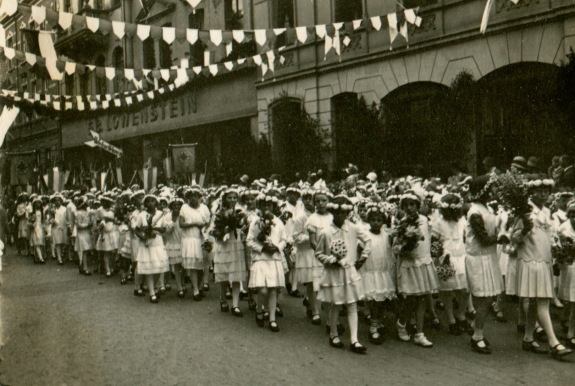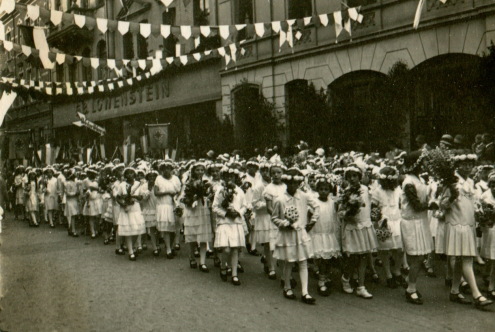Bocholt under the sign of Corpus Christi Day 1931
All of Bocholt on its feet
In May or June each year, Catholic Christians celebrate the feast of Corpus Christi.
In earlier times, this feast day was not yet a public holiday, but shops in this country often remained closed - at least in the morning. It was not an artificial routine that was repeated year after year. For the faithful, Corpus Christi was a day of true faithfulness, on which Bocholt was transformed into a city of Christ, a city of the Eucharist, for a few hours with a sacramental procession.
Staged major event
The procession began at 8 a.m., with the various groups of participants and members of the individual church associations lining up at specific points in the city centre. The procession then set off on its way through the town centre.
The photo shows the group of girls dressed uniformly in white at the Corpus Christi procession on 4 June 1931 in Osterstraße. They are walking past the textile department stores' of the Jewish merchant S. B. Löwenstein (owner Bertold Löwenstein) in the direction of the market. The so-called " angels" all wear wreaths of hair and carry bouquets or baskets of flowers. The turnout for the procession was so large that most of the participants didn't even know where the sacrament group with the monstrance had just arrived. At the four altars, the faithful sank to their knees during the blessing.
During the procession, the bells of St George's and Our Lady's Church rang out. As soon as the bells stopped ringing, everyone had to stand where they were. Everyone now understood that the shrine had arrived at one of the four stations. For the actual blessing, the large bell of Our Lady struck three times and the bell was rung within the procession. Then the continuous ringing of both town churches sounded again so that everyone understood that the procession was continuing.
Signs of popular piety
The final blessing was usually given in the market square. Otherwise, the clergy would make their way to the flag-wreathed high altar in the packed St George's Church, the organ would roar and the crowd would sing the solemn "Tantum Ergo" before the procession ended with the final blessing.
On no other occasion were there so many flags and colourful garlands along the route as on Corpus Christi. Small house altars could also be seen in the windows and doors of many homes. Thousands filled the streets with prayer and songs of praise, and for a good two hours there was little else to do but worship Christ in the form of the consecrated host presented in the monstrance.




